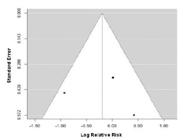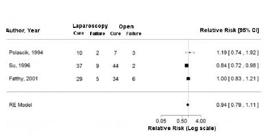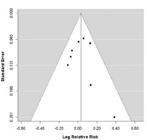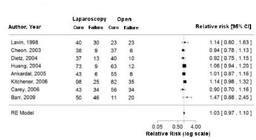ABSTRACT
The retropubic colposuspension in the treatment of stress urinary incontinence has been rescued with the laparoscopic route. Some authors have reduced the number of stitches, from two to one, due to the difficulty of suturing by this route. To what extent can this modification compromise outcome? To answer this question, we performed a systematic review and meta-analysis on the MEDLINE/PubMed and LILACS/SciELO databases between 1990 and 2015. We included randomized clinical trials, cohort studies and case-control series comparing laparoscopic versus open Burch, and two versus one stitch in laparoscopic Burch, with a minimum follow-up of one year. Fourteen studies compared laparoscopic versus open Burch, in which we found no differences between the two techniques using one stitch (Relative Risk - RR - of 0.94, 95% CI 0.79-1.11) and two stitches (RR of 1.03, 95% CI 0.97-1.10). Only one study compared one stitch versus two stitches in laparoscopic Burch, with cure rates of 68% versus 87%, respectively (p-value= 0.02). We did not identify differences when compared open technique with two stitches versus laparoscopic with one stitch and open technique with two stitches versus laparoscopic with two. The study comparing one versus two laparoscopic stitches demonstrated superior results with the latter. Although there is no robust evidence, when Burch surgery is performed laparoscopically, the use of two stitches seems to be the best option.
Keywords:
Urinary Incontinence; Stress. Laparoscopy. Treatment Outcome. Review. Meta-Analysis.
RESUMO
A colpossuspensão retropúbica no tratamento da incontinência urinária de esforço vem sendo resgatada com a via laparoscópica. Alguns autores reduziram o número de suturas, de duas para uma, devido à dificuldade de sutura por esta via. Até que ponto essa modificação pode comprometer o resultado? Para responder a esta pergunta, foi realizada uma revisão sistemática e metanálise nas bases de dados MEDLINE/PubMed e LILACS/SciELO entre 1990 e 2015. Incluímos ensaios clínicos randomizados, estudos de coorte, caso controle, comparando Burch laparoscópico versus Burch aberto e duas versus uma sutura no Burch laparoscópico, com follow-up mínimo de um ano. Quatorze estudos compararam Burch laparoscópico versus aberto, nos quais não encontramos diferenças entre as duas técnicas, utilizando uma sutura (Risco Relativo (RR) de 0,94 [IC 95% - 0,79-1,11]) e duas suturas (RR de 1,03 [IC 95% - 0,97-1,10]). Apenas um estudo comparou uma sutura versus duas suturas no Burch laparoscópico, com taxas de cura de 68% versus 87%, respectivamente (p-valor=0,02). Quando comparadas técnica aberta com duas suturas versus laparoscópica com uma sutura e técnica aberta com duas suturas versus laparoscópica com duas suturas, não identificamos diferenças. O estudo que comparou uma versus duas suturas laparoscópicas demonstrou resultado superior com a técnica de duas suturas. Apesar de não haver evidências robustas, quando a cirurgia de Burch for realizada por via laparoscópica, o uso de duas suturas parece ser a melhor opção.
Descritores:
Incontinência Urinária por Estresse; Laparoscopia; Resultado do Tratamento; Revisão; Metanálise.
INTRODUCTION
In 1961, Burch described the surgical technique of suspending the urethra and abdominal vagina using the Cooper’s ligament as a point of support in the treatment of stress urinary incontinence (SUI)11. Burch JC. Urethrovaginal fixation to Cooper's ligament for correction of stress incontinence, cystocele, and prolapse. Am J Obstet Gynecol. 1961;81:281-90.. Tanagho22. Tanagho EA. Colpocystourethropexy: the way we do it. J Urol. 1976;116(6):751-3. subsequently described the technique modification, not completely approaching the endopelvic fascia to the Cooper ligaments, which is described in most articles.
The long-term success of Burch’s open (OB) operation was demonstrated by Sivaslioglu et al.33. Sivaslioglu AA, Unlubilgin E, Keskin HL, Gelisen O, Dolen I. The management of recurrent cases after the Burch colposuspension: 7 years experience. Arch Gynecol Obstet. 2011;283(4):787-90. in 262 patients with 84% cure rate at seven years. In 1991, the technique was first described laparoscopically (LB)44. Vancaillie TG, Schuessler W. Laparoscopic bladderneck suspension. J Laparoendosc Surg. 1991;1(3):169-73.. Prezioso et al.55. Prezioso D, Iacono F, Di Lauro G, Illiano E, Romeo G, Ruffo A, et al. Stress urinary incontinence: long-term results of laparoscopic Burch colposuspension. BMC Surg. 2013;13 Suppl 2:S38. Retraction in: Prezioso D, Iacono F, Di Lauro G, Illiano E, Romeo G, Ruffo A, et al. BMC Surg. 2016;16(1):26. carried out a randomized study using the laparoscopic technique in 96 women, with similar results to OB, but with significant advantages such as less bleeding and less time to return to work.
One of the difficulties in comparing the results of the open technique with the laparoscopic one is caused by the various modifications made in the laparoscopic route, more frequently in the number of stitches, which require more time and training when performed by that pathway. Some authors performed surgeries using one or two stitches on either side of the urethra, perhaps in order to reduce surgical time.
The objective of this study was to evaluate, through a systematic review of the literature, whether the laparoscopic Burch technique with two stitches on each side of the urethra is superior to that performed with a single stitch and, secondarily, to verify if the laparoscopic technique with one and two stitches is better than the open, classic Burch with two stitches.
METHODS
We performed a systematic search in the MEDLINE/PubMed and LILACS/SciELO databases for articles published from 1990 to 2015 in the English, Portuguese or Spanish languages. Using the keywords “laparoscopy”, “laparoscopic”, “burch”, “colposuspension”, “urethropexy” and “urinary incontinence”, we developed the following search strategy: AND (burch OR urethropexy OR colposuspension) AND (laparoscopy OR laparoscopic).
The inclusion criteria of the articles were randomized clinical trials, cohort and case-control studies comparing laparoscopic Burch with two stitches with those who performed one stitch on each side of the urethra, as well as randomized clinical trials, cohort and case-control studies comparing laparoscopic Burch with classic open Burch with two stitches.
The studies had to inform the follow-up time, of at least one year, to clearly describe the technique used in each group, separating them (one or two stitches on each side of the urethra) and to describe the criteria used to evaluate treatment results. We excluded studies that did not report whether patients had undergone previous surgeries for urinary incontinence or in which there was no uniform distribution between groups with previous treatment for incontinence.
Based on these criteria, two independent examiners (RJS and JADRJr) evaluated all selected articles, in three stages: evaluation by the titles (first stage), then evaluation by the abstracts (second stage) and finally evaluation of the articles in full (third stage). For the articles that generated conflicts between the examiners, we held consensus meetings, involving a mediator for final decision (LCSB)
We used the Oxford criteria66. Centre for Evidence-based Medicine. Oxford Centre for Evidence-based Medicine - Levels of Evidence (March 2009) [Internet]. CEBM. 2009 [cited 2016 May 5]. Available from: http://www.cebm.net/oxford-centre-evidence-based-medicine-levels-evidence-march-2009/
http://www.cebm.net/oxford-centre-eviden...
to define the levels of scientific evidence.
RESULTS
We found 273 studies in MEDLINE/PubMed and none in LILACS/SciELO. Of those, we selected fifteen studies, 14 of which compared laparoscopic and open techniques and one compared one with stitches on each side of the urethra through the laparoscopic route. Of the 14 studies comparing open laparoscopic techniques, we excluded two, one for reporting results with less than one year of follow-up77. Bezerra CA, Rodrigues AO, Seo AL, Ruano JMC, Borrelli M, Wroclawski ER. Laparoscopic Burch surgery: is there any advantage in relation to open approach? Int Braz J Urol. 2004;30(3):230-6. and another for having included in the laparoscopic group women treated with one and two stitches, not being possible to analyze the data separately88. Lyons TL, Winer WK. Clinical outcomes with laparoscopic approaches and open Burch procedures for urinary stress incontinence. J Am Assoc Gynecol Laparosc. 1995;2(2):193-8..
The 12 studies included in this review compared the results of OB with LB, two of which were randomized and controlled, one retrospective cohort study and one retrospective using only one stitch on each side of the urethra. The others used two stitches on each side of the urethra, one being a case-control, three retrospective cohorts and four randomized and controlled studies (Table 1).
Meta-Analyzes
Two-stitch OB versus one-stitch LB
Of the four articles that compared the two-stitch OB versus LB techniques using only one stitch, it was possible to perform a meta-analysis with only three of the studies due to the divergence of the techniques used (Figures 1 and 2).
Funnel plot - analysis considering the three selected publications 9 9. Polascik TJ, Moore RG, Rosenberg MT, Kavoussi LR. Comparison of laparoscopic and open retropubic urethropexy for treatment of stress urinary incontinence. Urology. 1995;45(4):647-52. , 11 11. Su TH, Wang KG, Hsu CY, Wei HJ, Hong BK. Prospective comparison of laparoscopic and traditional colposuspensions in the treatment of genuine stress incontinence. Acta Obstet Gynecol Scand. 1997;76(6):576-82. , 12 12. Fatthy H, El Hao M, Samaha I, Abdallah K. Modified Burch colposuspension: laparoscopy versus laparotomy. J Am Assoc Gynecol Laparosc. 2001;8(1):99-106. ; total heterogeneity/variability (I 2 2. Tanagho EA. Colpocystourethropexy: the way we do it. J Urol. 1976;116(6):751-3. ) = 40.11% (p =0.038).
Forest Plot - relative risk assessing cure between studies involving LB versus OB techniques.
Two-stitch OB versus two-stitch LB
By extracting the information from the eight articles that compared the two-stitch OB versus the two-stitch LB, we did not observe statistical difference between the two groups (Figures 3 and 4).
Funnel plot - analysis considering the eight selected publications 12 12. Fatthy H, El Hao M, Samaha I, Abdallah K. Modified Burch colposuspension: laparoscopy versus laparotomy. J Am Assoc Gynecol Laparosc. 2001;8(1):99-106.
13. Lavin JM, Lewis CJ, Foote AJ, Hosker GL, Smith AR. Laparoscopic Burch colposuspension: a minimum of 2 years' follow up and comparison with open colposuspension. Gynaecol Endosc. 1998;7(5):251-8.
14. Huang WC, Yang JM. Anatomic comparison between laparoscopic and open Burch colposuspension for primary stress urinary incontinence. Urology. 2004;63(4):676-81; discussion 681.
15. Barr S, Reid FM, North CE, Hosker G, Smith AR. The long-term outcome of laparoscopic colposuspension: a 10-year cohort study. Int Urogynecol J Pelvic Floor Dysfunct. 2009;20(4):443-5.
16. Dietz HP, Wilson PD. Laparoscopic colposuspension versus urethropexy: a case-control series. Int Urogynecol J Pelvic Floor Dysfunct. 2005;16(1):15-8; discussion 18.
17. Cheon WC, Mak JHL, Liu JYS. Prospective randomised controlled trial comparing laparoscopic and open colposuspension. Hong Kong Med J Xianggang Yi Xue Za Zhi Hong Kong Acad Med. 2003;9(1):10-4. - 18 18. Carey MP, Goh JT, Rosamilia A, Cornish A, Gordon I, Hawthorne G, et al. Laparoscopic versus open Burch colposuspension: a randomised controlled trial. BJOG. 2006;113(9):999-1006. ; total heterogeneity/variability (I2) = 11.89% (p=0.007).
Forest Plot - relative risk assessing cure between studies involving the LB versus OB techniques.
DISCUSSION
Regarding published studies comparing OB versus LB, some authors used different techniques, especially when it comes to the number of stitches used in the laparoscopic route. Polascik et al.99. Polascik TJ, Moore RG, Rosenberg MT, Kavoussi LR. Comparison of laparoscopic and open retropubic urethropexy for treatment of stress urinary incontinence. Urology. 1995;45(4):647-52., in 1994, performed a retrospective cohort study (Level of Evidence 4). They analyzed data from 22 patients, 12 of whom were submitted to LB and ten to OB. With an average follow-up period of 20.8 months, they found similar cure rates (LB=83% vs OB=70%, p-value non-significant). In that study, the authors described performing the laparoscopic technique with one stitch on each side of the urethra. Subsequently, in 1998, Miannay et al.1010. Miannay E, Cosson M, Lanvin D, Querleu D, Crepin G. Comparison of open retropubic and laparoscopic colposuspension for treatment of stress urinary incontinence. Eur J Obstet Gynecol Reprod Biol. 1998;79(2):159-66., also using one stitch on each side in the laparoscopic technique, performed a retrospective study (Level of Evidence 4) comparing the data of 144 patients submitted to LB and OB, finding no statistical difference between the cure rate of the two procedures (LB=68% vs OB=64%, p-value non-significant) after a 24-month follow-up. These authors performed laparoscopic surgeries with only one stitch on each side of the urethra comparing with the two classic stitches by the open technique.
In the same line of previous studies, we found two prospective studies that were published using one stitch on each side of the urethra in the laparoscopic technique. Su et al.1111. Su TH, Wang KG, Hsu CY, Wei HJ, Hong BK. Prospective comparison of laparoscopic and traditional colposuspensions in the treatment of genuine stress incontinence. Acta Obstet Gynecol Scand. 1997;76(6):576-82., in a controlled, randomized, prospective study (Level of Evidence 1B) conducted in 1996, studied 72 patients with a minimum follow-up period of 12 months, dividing into two groups. The cure rate for patients submitted to LB was 80.4% and 95.6% for OB (p-value non-significant). This was the only study that found a laparoscopic surgical time shorter than the open technique.
The second controlled, randomized, prospective study (Level of Evidence 1B) conducted by Fatthy et al. 12 compared 40 women in the LB group and 34 in the OB group. The authors performed only one stitch on each side of the urethra, both in the laparoscopic surgery and in the open procedure, and also found no difference in cure rates (OB=85% vs LB=87.9%, p-value non-significant).
When we analyzed the studies with two stitches on each side of the urethra, we found a retrospective cohort study (Level of Evidence 4) conducted in 1998 by Lavin et al.1313. Lavin JM, Lewis CJ, Foote AJ, Hosker GL, Smith AR. Laparoscopic Burch colposuspension: a minimum of 2 years' follow up and comparison with open colposuspension. Gynaecol Endosc. 1998;7(5):251-8., who reviewed the data of two years and the complaints, by telephone contact, of 70 women submitted to LB and 46 submitted to OB. They found subjective cure in 57.8% and 50% patients, respectively (p-value non-significant). Two aspects are important in the analysis of this study: the suture used in the laparoscopic Burch was absorbable (polydioxanone-PDS), different from the open technique and from other studies, which used nonabsorbable sutures, and OB follow-up time was two years longer than LB.
Huang et al.1414. Huang WC, Yang JM. Anatomic comparison between laparoscopic and open Burch colposuspension for primary stress urinary incontinence. Urology. 2004;63(4):676-81; discussion 681. conducted a retrospective cohort study (Level of Evidence 4) with the use of two stitches and non-absorbable suture. They compared 75 patients in the open procedure with 82 in the laparoscopic one and found a subjective success rate of 84% for OB and 89% for LB, with follow-up of at least one year.
In a third study in the same vein, Barr et al.1515. Barr S, Reid FM, North CE, Hosker G, Smith AR. The long-term outcome of laparoscopic colposuspension: a 10-year cohort study. Int Urogynecol J Pelvic Floor Dysfunct. 2009;20(4):443-5. reviewed a series (Level of Evidence 4) of 139 women submitted to LB between 1993 and 1995 and compared with 52 patients submitted to OB in the same period. In a long-term evaluation (10 years), there was no difference between cure rates in the two techniques. However, there was a significant drop in cure rates over time in both groups. The results were 58% and 50% in two years (p=0.364) and 48% and 32% (p=0.307) in ten years (LB versus OB, respectively).
In a case control study (Level of Evidence 3B) of 50 patients in each group, Dietz et al.1616. Dietz HP, Wilson PD. Laparoscopic colposuspension versus urethropexy: a case-control series. Int Urogynecol J Pelvic Floor Dysfunct. 2005;16(1):15-8; discussion 18., in 2004, did not find statistical differences between the two procedures by using subjective cure criteria. During the effort, 37 women from the LB group and 40 from the OB one remained dry (p-value non-significant).
We found four prospective, randomized studies in the review comparing the two techniques. Cheon et al.1717. Cheon WC, Mak JHL, Liu JYS. Prospective randomised controlled trial comparing laparoscopic and open colposuspension. Hong Kong Med J Xianggang Yi Xue Za Zhi Hong Kong Acad Med. 2003;9(1):10-4., in 2003, in a clinical trial (Level of Evidence 1B) with 90 women presenting SUI, found no statistical difference between the two techniques. Considering cure and improvement of SUI, they found 80.9% and 86% success in one year of follow-up, in the laparoscopic and open path, respectively (p-value non-significant).
In 2006, Carey et al.1818. Carey MP, Goh JT, Rosamilia A, Cornish A, Gordon I, Hawthorne G, et al. Laparoscopic versus open Burch colposuspension: a randomised controlled trial. BJOG. 2006;113(9):999-1006. conducted a study with 200 incontinent women (Level of Evidence 1B). After 24 months of follow-up, there was no difference between groups regarding urinary incontinence, with 66% of the women remaining continent. The authors observed a twice-longer surgical time in the laparoscopic approach, but with less blood loss and postoperative pain.
Ankardal et al.1919. Ankardal M, Milsom I, Stjerndahl JH, Engh ME. A three-armed randomized trial comparing open Burch colposuspension using sutures with laparoscopic colposuspension using sutures and laparoscopic colposuspension using mesh and staples in women with stress urinary incontinence. Acta Obstet Gynecol Scand. 2005;84(8):773-9., in a study (Level of Evidence 1B) including 211 patients (OB=79, LB=53 and laparoscopic mesh colposuspension =79) found no difference between techniques that used stitches at one year of follow-up, with 56% of women with OB and 55% with LB without complaints or urinary losses (p-value non-significant. Kitchener et al.2020. Kitchener HC, Dunn G, Lawton V, Reid F, Nelson L, Smith ARB; COLPO Study Group. Laparoscopic versus open colposuspension--results of a prospective randomised controlled trial. BJOG. 2006;113(9):1007-13. found an objective cure rate (negative pad test) of 80% for laparoscopy and 70% with the open technique in a two-year follow-up.
We found a single published article comparing the technique of two stitches with the one of one stitch on each side of the urethra using the laparoscopic approach. Persson et al.2121. Persson J, Wølner-Hanssen P. Laparoscopic Burch colposuspension for stress urinary incontinence: a randomized comparison of one or two sutures on each side of the urethra. Obstet Gynecol. 2000;95(1):151-5. conducted a randomized study (Level of Evidence 1B) using the colposuspension technique with fixation in the Cooper ligaments, laparoscopically, comparing one or two stitches on each side of the urethra. They excluded patients with previous surgical treatment for urinary incontinence. In patients with one stitch on each side, they performed two passes of the needle by the vaginal fascia (dubbed-bite), while in those with two stitches, they passed the thread only once in the fascia. They analyzed data from 83 women submitted to the one stitch technique and from 78 treated with two stitches. In that series, after one year of follow-up, in the group with two stitches 62 patients (83%) achieved an objective cure and 9 (12%) improved symptoms, compared with 43 (58%) cures and 20 (27%) improvements in those submitted to one stitch (p=0.001). They considered objective cure the absence of urinary loss in the pad test. There was no difference in the incidence of intra and postoperative complications between groups. The group in which two stitches were performed had a longer operative time (median of 17 minutes). The authors interrupted the study on ethical grounds after assessing the results of the first 108 women in the one-year follow-up. At this time, the group with one stitch had a healing result lower than the group of two stitches (68% versus 87%, p=0.02), but the data of 60 women had not yet been evaluated and were subsequently added.
CONCLUSIONS
When comparing open and laparoscopic techniques, even the best level of evidence studies could not identify differences between procedures with one or two stitches. The only study found comparing one versus two stitches performed laparoscopically demonstrated that the result was superior with the technique using two stitches on each side of the urethra. Despite the lack of robust evidence, when Burch is performed by laparoscopy, the best option seems to be the use of two stitches, especially nowadays, when there is a trend in the advancement of laparoscopic suture techniques.
REFERENCES
-
1Burch JC. Urethrovaginal fixation to Cooper's ligament for correction of stress incontinence, cystocele, and prolapse. Am J Obstet Gynecol. 1961;81:281-90.
-
2Tanagho EA. Colpocystourethropexy: the way we do it. J Urol. 1976;116(6):751-3.
-
3Sivaslioglu AA, Unlubilgin E, Keskin HL, Gelisen O, Dolen I. The management of recurrent cases after the Burch colposuspension: 7 years experience. Arch Gynecol Obstet. 2011;283(4):787-90.
-
4Vancaillie TG, Schuessler W. Laparoscopic bladderneck suspension. J Laparoendosc Surg. 1991;1(3):169-73.
-
5Prezioso D, Iacono F, Di Lauro G, Illiano E, Romeo G, Ruffo A, et al. Stress urinary incontinence: long-term results of laparoscopic Burch colposuspension. BMC Surg. 2013;13 Suppl 2:S38. Retraction in: Prezioso D, Iacono F, Di Lauro G, Illiano E, Romeo G, Ruffo A, et al. BMC Surg. 2016;16(1):26.
-
6Centre for Evidence-based Medicine. Oxford Centre for Evidence-based Medicine - Levels of Evidence (March 2009) [Internet]. CEBM. 2009 [cited 2016 May 5]. Available from: http://www.cebm.net/oxford-centre-evidence-based-medicine-levels-evidence-march-2009/
» http://www.cebm.net/oxford-centre-evidence-based-medicine-levels-evidence-march-2009 -
7Bezerra CA, Rodrigues AO, Seo AL, Ruano JMC, Borrelli M, Wroclawski ER. Laparoscopic Burch surgery: is there any advantage in relation to open approach? Int Braz J Urol. 2004;30(3):230-6.
-
8Lyons TL, Winer WK. Clinical outcomes with laparoscopic approaches and open Burch procedures for urinary stress incontinence. J Am Assoc Gynecol Laparosc. 1995;2(2):193-8.
-
9Polascik TJ, Moore RG, Rosenberg MT, Kavoussi LR. Comparison of laparoscopic and open retropubic urethropexy for treatment of stress urinary incontinence. Urology. 1995;45(4):647-52.
-
10Miannay E, Cosson M, Lanvin D, Querleu D, Crepin G. Comparison of open retropubic and laparoscopic colposuspension for treatment of stress urinary incontinence. Eur J Obstet Gynecol Reprod Biol. 1998;79(2):159-66.
-
11Su TH, Wang KG, Hsu CY, Wei HJ, Hong BK. Prospective comparison of laparoscopic and traditional colposuspensions in the treatment of genuine stress incontinence. Acta Obstet Gynecol Scand. 1997;76(6):576-82.
-
12Fatthy H, El Hao M, Samaha I, Abdallah K. Modified Burch colposuspension: laparoscopy versus laparotomy. J Am Assoc Gynecol Laparosc. 2001;8(1):99-106.
-
13Lavin JM, Lewis CJ, Foote AJ, Hosker GL, Smith AR. Laparoscopic Burch colposuspension: a minimum of 2 years' follow up and comparison with open colposuspension. Gynaecol Endosc. 1998;7(5):251-8.
-
14Huang WC, Yang JM. Anatomic comparison between laparoscopic and open Burch colposuspension for primary stress urinary incontinence. Urology. 2004;63(4):676-81; discussion 681.
-
15Barr S, Reid FM, North CE, Hosker G, Smith AR. The long-term outcome of laparoscopic colposuspension: a 10-year cohort study. Int Urogynecol J Pelvic Floor Dysfunct. 2009;20(4):443-5.
-
16Dietz HP, Wilson PD. Laparoscopic colposuspension versus urethropexy: a case-control series. Int Urogynecol J Pelvic Floor Dysfunct. 2005;16(1):15-8; discussion 18.
-
17Cheon WC, Mak JHL, Liu JYS. Prospective randomised controlled trial comparing laparoscopic and open colposuspension. Hong Kong Med J Xianggang Yi Xue Za Zhi Hong Kong Acad Med. 2003;9(1):10-4.
-
18Carey MP, Goh JT, Rosamilia A, Cornish A, Gordon I, Hawthorne G, et al. Laparoscopic versus open Burch colposuspension: a randomised controlled trial. BJOG. 2006;113(9):999-1006.
-
19Ankardal M, Milsom I, Stjerndahl JH, Engh ME. A three-armed randomized trial comparing open Burch colposuspension using sutures with laparoscopic colposuspension using sutures and laparoscopic colposuspension using mesh and staples in women with stress urinary incontinence. Acta Obstet Gynecol Scand. 2005;84(8):773-9.
-
20Kitchener HC, Dunn G, Lawton V, Reid F, Nelson L, Smith ARB; COLPO Study Group. Laparoscopic versus open colposuspension--results of a prospective randomised controlled trial. BJOG. 2006;113(9):1007-13.
-
21Persson J, Wølner-Hanssen P. Laparoscopic Burch colposuspension for stress urinary incontinence: a randomized comparison of one or two sutures on each side of the urethra. Obstet Gynecol. 2000;95(1):151-5.
-
Source of funding:
none.
Publication Dates
-
Publication in this collection
Nov-Dec 2017
History
-
Received
01 June 2017 -
Accepted
21 July 2017









